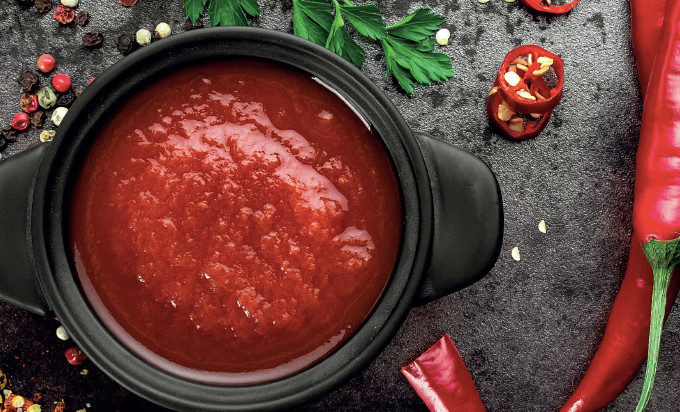This article – explaining the ins and outs of chilli and chilli culture – was brought to you by our resident gardening expert, Hans Wieland in our Spring 2018 issue. He also provided us with a delicious chilli sauce recipe. Here, we share the article in its entirety. Read it and learn how to bring a touch of inspiration into your kitchen!

The Cult of Chillies: Growing vegetables that make a difference
By Hans Wieland
Chilli Peppers, Bell Peppers, Hot Peppers, Sweet Peppers, Cayenne Peppers, Spanish Peppers, Red Hot Chili Peppers, what have they all in common? Confused?
Ok, the last “variety” the Red Hot Chili Peppers, a funk-rock band from Los Angeles is only around since 1983, and all the others have nothing in common with black pepper (Piper nigrum), but are in fact all species of the genus Capsicum. Commonly we distinguish between the sweet and mild peppers and the hot and more pungent chillies, the topic of our article. Most of our common chillies come from one species, Capsicum annum, which was first cultivated in Mexico at least 5000 years ago.
The cult story of chillies begins with Columbus, who thought he found the (black) pepper and continues with the colonial trading power of the Portuguese bringing the chilli everywhere, leading to India becoming the biggest producer. The Aztec word of the native Nahuatl was chilli, which means red. Botanically speaking all peppers are fruits; however, they are correctly considered vegetables in a culinary context. The success story of the chilli is remarkable as the world production and consumption is now 20 times that of black pepper, the other major pungent spice (On Food and Cooking, p 418).
Hungary has its Paprika, Spain its Pimenton, Italy its Peperoni and in China chilli is a major spice in Sichuan and Hunan, but Mexico remains the most advanced country when it comes to chilli culture, it being a major ingredient in Salsas. At Neantog Kitchen Garden School we grow it mainly to produce our own sauces (see recipe below). The beauty of growing it yourself is in the choice of varieties, from mild to super-hot.
What makes Chillies so special?
It is Capsaicin, the active chemical ingredient, contained in the placenta, the tissue that bears the seeds. The variety and the growing conditions – high temperatures and the length of the season – contribute to the amount of capsaicin produced. The heat of a chilli is measured on the Scoville Scale in Scoville heat units (SHU), or capsaicin concentration, named after its creator, US pharmacist Wilbur Scoville. SHU values range from 0 in a sweet bell pepper to 2,000,000-2,200,000 in a Trinidad Moruga Scorpion or Carolina Reaper. Naturally, there is the burning sensation in our mouth which for some is pure pleasure.
How to grow chillies
As Chillies love heat and light, it makes them an ideal crop for growing in polytunnels in Ireland. Some varieties are also suitable for pots in a conservatory. Two or three plants yield more than enough for a family for a year. Chilli peppers require a long growing season and are best sown from early February until mid-March at the latest. I sow them in modules on a heat propagator at 20 degrees Celsius. Once they have germinated I transfer them to 7cm wide pots using potting compost. Three or four weeks later they can be potted on to 1litre pots. In early May in mild areas or in mid- to late-May in cooler areas I plant them into the polytunnel spaced 50cm apart and staked, to prevent them from falling over when the branches get heavy with fruits. Apart from regular watering, there is little else you need to do.
Chillies can be harvested throughout the summer whenever required. All chillies start off green and then turn into their final colour. Green chillies are a little less hot. Towards the end of the growing season in October I usually harvest all the remaining chillies and dry them in the kitchen. They will last for well over a year.
Here are my favourite varieties:
Jalapeno, (C. annuum), a classic from Mexico, with bullet shaped fruits, green to red and medium hot (2500 – 8000 SHU)
Ring of Fire, Cayenne type, (C. annuum), long, thin, pointed pods, (30 000 – 50 000 SHU)
Tabasco, (C. frutescens), named after the Mexican state Tabasco and also the name of the Louisiana produced hot sauce, (30 000 – 50 000 SHU). The chilli for the fermenters to make their own variety of the famous sauce.
Habanero, (C. chinense), from Cuba, small bell shaped, yellow, orange or red, (100 000 – 350 000 SHU)
Numex Twilight (C. annuum), the best windowsill chilli I’ve grown; tiny, upright fruit that start purple and ripen to bright red, perfect for those without a garden, ( 30 000 – 50 000 SHU)
Neantog Chilli Sauce:
For 250ml you need:
6 small red chillies (we love Jalapeno, Cayenne and Ring of Fire)
5 cloves of garlic
40 grams ginger
1 stem of lemongrass
Juice of 1 lime/lemon
175 grams of brown sugar
3tsp sea salt
175ml of cider vinegar
175 ml of water
½ tsp of arrow root dissolved in 2 tbsp of water
Chop the chillies, garlic, ginger and lemongrass very finely (use gloves!), mix with the rest of the ingredients. Bring to the boil, reduce heat and let simmer for around 15 mins, then add the arrow root powder dissolved in water and bring to the boil to thicken. Fill in hot into sterile glass bottles, close and let cool.
Hans Wieland has worked and taught at The Organic Centre for over 20 years. In May he is “retiring” to Neantog Kitchen Garden School in Cliffoney, again joining his wife Gaby Wieland, herbalist and Naturopath. The couple offer a range of courses and workshops in food growing, fermenting, foraging, cheese making, healthy cooking and baking. www.neantog.com

